I have covered High Yield Dividend ETFs in the past, but most of those ETFs were more traditional in nature, paying yields of 5% or so, and the strategy is more focused on holding high-yield individual dividend stocks. Those ETFs invested in dividend paying stocks and shared the dividends earned with shareholders.
Today, we are going to focus on 4 high-yield ETFs, focused less on dividend stocks and more on paying huge yields. These are some insane yields these ETFs pay, and how they are able to do it is by utilizing options within their strategy.
High yields attract both income and retired investors alike.
And when I say huge yields, I mean it. Three of these high-yield ETFs are averaging distribution yields close to 60% on an annual basis. In today’s piece, we will go through these ETFs from the lowest yield and work our way up to the highest yield.
4 High-Yield ETFs Paying Huge Distributions
Before jumping into these ETFs, let me first begin with a couple of basics.
- Dividend Yield has an inverse relationship with stock price. As a stock price increases a dividend yield decreases and vice versa.
- ETFs utilizing options can risk share price erosion over time if option selling goes against your strategy
High Yield ETF #1 – JPMorgan Equity Premium Income ETF (JEPI)
JEPI is one of the most well-known high-yield ETFs and really one of the key ETFs that started a surge in new ETFs being filed with similar ETF strategies, a few of which we will cover later on. JEPI has assets under management of nearly $30 billion.
These types of funds are nothing new, nor is the strategy behind them, but JEPI hit the ground running and its popularity blew up in a time when investors were looking for yield in a time when the stock market was fragile during the pandemic.
JEPI came into action in May 2020. Since its inception, shares of JEPI have a total return of 46%.
yCharts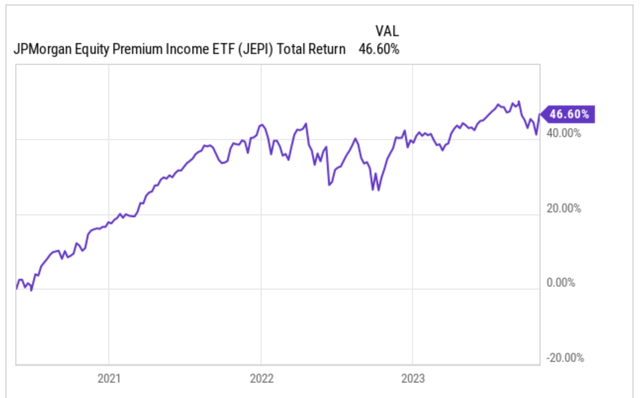
The strategy behind JEPI is a combination of owning low beta stocks as well as selling out of the money S&P 500 call options. The ETF earns dividends for the underlying positions they own that pay dividends, but the majority of their dividends come from what the fund managers are able to generate by selling those call options. Therefore, the distributions paid on a monthly basis will vary from month to month based on the success level of previous months.
Over the past 12 months, JEPI has paid out $4.98 per share which currently equates to a yield of 9.3%, which is a very high yield, but wait until you see the yields on the remaining three ETFs we look at.
JEPI website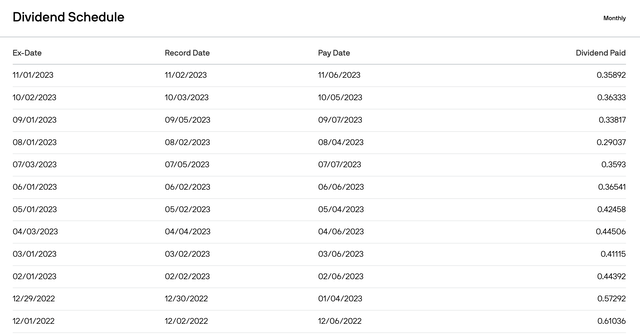
When it comes to selling covered calls, your upside is capped when markets are moving higher. This is evidenced by the fact that JEPI shares are flat over the past 12 months while the S&P 500 is up 17%.
JEPI has an expense fee of 0.35%, which is going to be the lowest of the group of funds we look at today, so the lowest yield and the lowest expense fee.
High Yield ETF #2 – YieldMax TSLA Option Income Strategy ETF (TSLY)
The next fund we are looking at is TSLY, which is an actively managed fund utilizing option writing to generate high amounts of income. The options TSLY writes are focused solely on TSLA, hence the fund symbol. TSLY currently has AUM of $747 million.
TSLY was formed in November 2022 and since then, the share price has fallen nearly 40%, however on a total return basis, TSLY has returned 1% when you include the income.
yCharts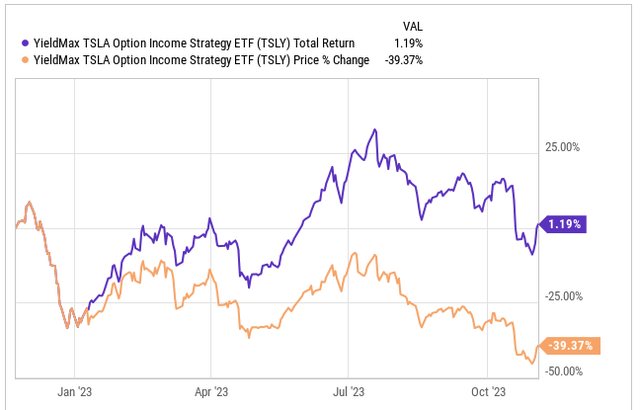
So how does TSLY work?
TSLY is selling out of the money call options on Tesla (TSLA). Shares of TSLA currently trade at $220 and the ETF has a call they sold at a strike price of $225. By selling the option, TSLY collected a premium for this and if TSLA shares climb above $225 prior to 11/10/23, TSLY has to sell shares at the $225 strike price. If shares stay below $225 by then, they keep their premium as a gain.
Many of the covered call ETFs, like JEPI, own underlying positions and then sell options on them. TSLY does not own any shares of TSLA but instead they create a synthetic position by purchasing a call, which as you can see in the top holdings the fund owns a TSLA call option with a $190 strike, meaning they have the right to buy shares at $190 strike.
There is a lot of risk that comes with this strategy considering the volatility behind the underlying stock which is TSLA.
Other positions the fund owns are US Treasuries and cash.
TSLY website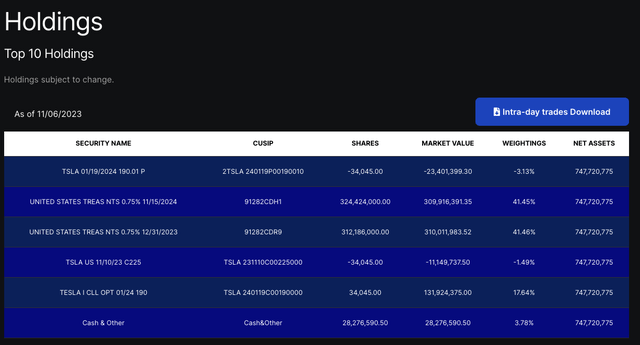
In terms of distributions, TSLY also pays out a monthly dividend, like every ETF we look at today, and it will vary depending on the success of the strategy in recent months.
The fund currently yields a high distribution rate of 57%.
TSLY website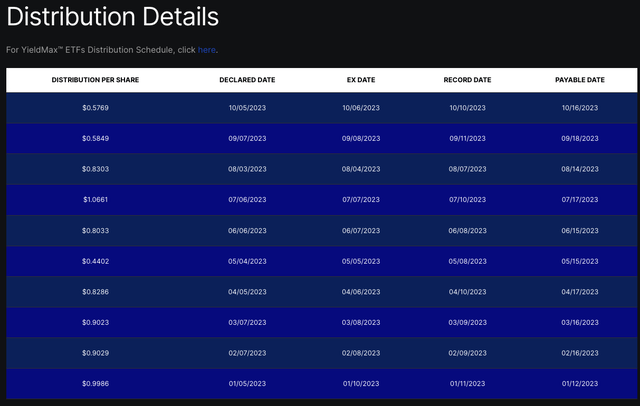
TSLY operates with an expense ratio of 0.99%.
High Yield ETF #3 – Defiance S&P 500 Enhanced Options Income ETF (JEPY)
This ETF is extremely new to the market having gone live in September of 2023, so only a few months old.
JEPY is the first put-write ETF on the S&P 500 using daily options expiring within 24 hours. Options can add a completely new level of risk to your portfolio, and there are a number of ways to play options, but options expiring within 24 hours can generate a lot of yield for those writing the options, aka selling the option, when things work in their favor.
JEPY Website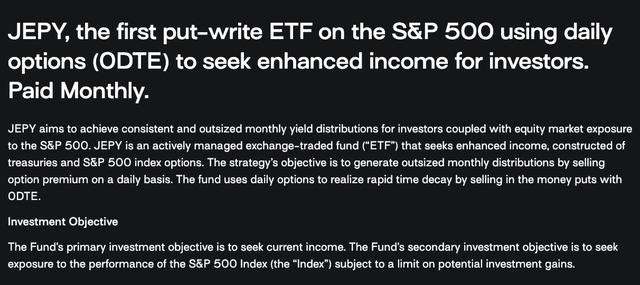
The first ETF we looked at today, JEPI, holds positions and sells out of the money calls. JEPY holds zero positions and instead writes puts and owns short-term treasuries to drum up huge amounts of yield. The puts they are writing focus solely on the S&P 500.
The strategy is not complex at all. Sell one S&P 500 put option that expires tomorrow, collect premium for that, and if the S&P 500 stays flat or increases in value from that point, the fund keeps 100% of the premium. If the S&P 500 falls below, the fund owes money.
The entire strategy is focused on taking advantage of rapid time decay while turning huge margins when the strategy works.
Here is a look at the holdings for JEPY. You will find a 1-year treasury bond, a 1-month treasury bond, cash, and then the put option they wrote on Friday November 3rd, which expires on Monday November 6th. On Monday November 6th that option will expire and they will write another that expires the next day.
JEPY website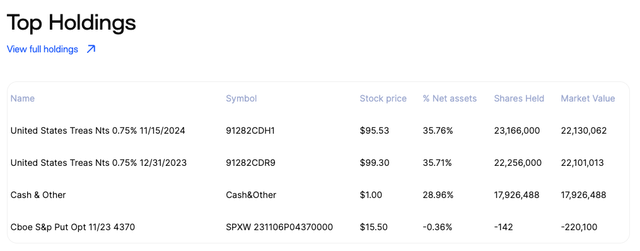
JEPY also pays a monthly dividend, and to date they have only been around long enough to pay two monthly dividends and if we annualize those payments, JEPY currently has a distribution rate of 59.2%.
Since inception, JEPY shares have fallen 10% in two months but on a total return they have generated a 1% loss.
yCharts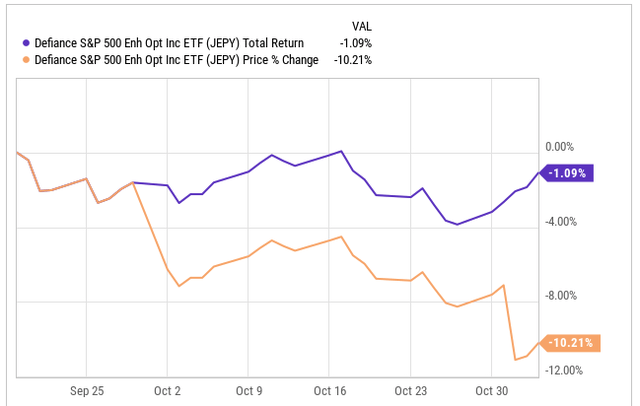
The entire goal is to generate huge amounts of income through this strategy but given that they are selling 0DTE options, there are plenty of inherent risks as well.
JEPY currently has $59.6 million in AUM and has an expense ratio of 0.99%, which is definitely on the high side, but if they can continue to generate income like they plan to, it would warrant the high expense fee.
High Yield ETF #4 – Defiance Nasdaq 100 Enhanced Options Income ETF (QQQY)
The final high-yield ETF we are looking at today, QQQY, is a sister fund to the ETF we just looked at in JEPY. Defiance is looking to generate huge amounts of income in both of these ETFs.
As you can imagine, the strategies are very similar to one another, almost exact to be honest with you. Where JEPY focuses on writing 0DTE puts on the S&P 500, QQQY is writing 0DTE puts on QQQ.
Again, the same amount of risk with options expiring less than 24 hours from making the trade, but the underlying indexes are difference.
QQQY went public in September 2023, so again a brand new ETF to keep an eye on if you are searching for some huge income options, literally.
Here is a look at QQQY’s holdings.
QQQY website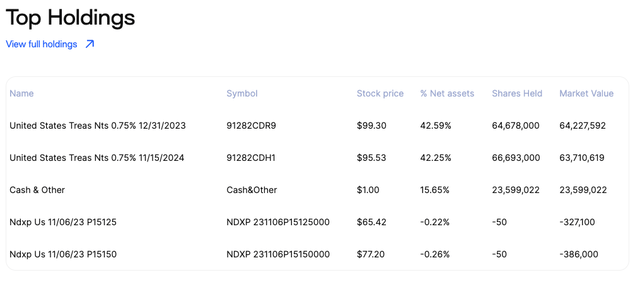
Since inception in September, QQQY shares have fallen 12%, but on a total return basis, they have generated a 1% loss, almost identical to JEPY.
QQQY, like all the other funds, also pays a monthly distribution, which is generated entirely by option writing and US Treasuries. Based on the few distributions already paid, when annualized, QQQY is generating an annualized distribution rate of 65.78%, the highest on our list today.
QQQY website
QQQY also charges an expense fee of 0.99%.
Investor Takeaway
Today, we look at 4 high-yield ETFs, and when I mean high yield, I really mean it. Many of you are likely familiar with JEPI, but less familiar with the newer funds in TSLY, JEPY, and QQQY, which all utilize options to generate huge amounts of income that are distributed on a monthly basis.
There is plenty of risk baked into each of these ETFs, and some where your upside is capped. These strategies can see the erosion of the share price, which is a reason I am not a huge fan of them.
In fact, I do not have a position in any of these ETFs, and one reason is because I am actively trading options on a weekly basis, but I also do not like the erosion of the share price. When you look out over the past 12 months or since inception, every ETF is negative on a share price basis with total return lurking around 0%.
This is not enticing to me and why I always say it is important to not invest based on yield alone. The yields these ETFs are generating look great as a headline number, but it is difficult to generate increasing returns month in and month out, but a few are brand new so the jury is still out on them.
In the comment section below, let me know if you like any of these high-yield ETFs we have covered today.
Disclosure: This article is intended to provide information to interested parties. I have no knowledge of your individual goals as an investor, and I ask that you complete your own due diligence before purchasing any stocks mentioned or recommended.
Read the full article here



